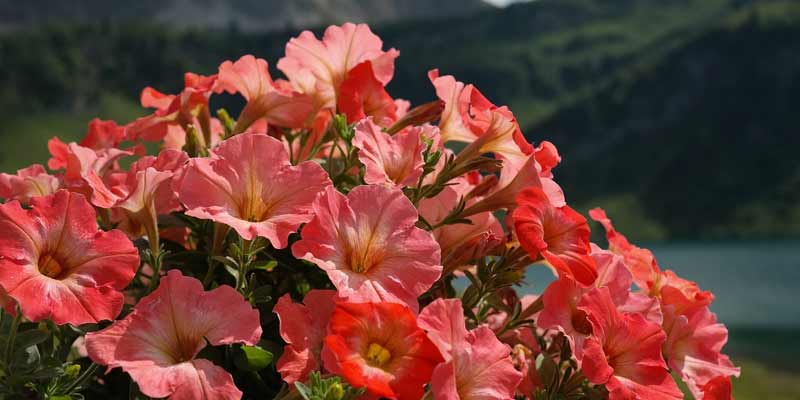Gardeners, seeking to infuse their outdoor spaces with beauty and charm, favor the popular choice of petunias. With delicate petals in vibrant colors – these annuals offer a versatile variety of cultivars: each presents its unique blend of hues and patterns. Although renowned for resilience and adaptability; petunias do not stand impervious against frost’s challenges.
This article delves into the complex relationship between petunias and frost, examining their tolerance towards cold temperatures, how they respond to damage from frost and strategies employed for protection during chilly weather.
Exploring Petunias
Belonging to the Solanaceae family, Petunias (Petunia spp.) originates from South America—specifically Argentina and Brazil. Cultivators have valued these flowering plants for centuries due to their abundant blooms and prolonged flowering seasons. Various forms of petunias include grandiflora, multiflora, and milliflora; each type offers unique characteristics that cater to diverse gardening preferences.
Their versatility and adaptability to diverse growing conditions make petunias a favorite: they thrive in full sun; their roots revel in well-drained soil. Commonly employed additions–flower beds, containers, hanging baskets, and border plantings benefit from the splash of color and elegance that petunias provide; this elevates gardens’ charm as much as it enhances balconies or patios.
Understanding Frost and Its Effects on Petunias
When temperatures plummet below the freezing point (32°F or 0°C), water vapor in the air condenses and forms ice crystals on surfaces – this is frost. Frost proves to be a formidable obstacle for petunias as its extended exposure to these freezing conditions can mar tender foliage, and hinder flower development; furthermore, it jeopardizes overall plant health.
Like numerous annual flowers, petunias prove sensitive to frost and may endure diverse levels of damage. The degree of this harm hinges on elements such as cultivar type, growth stage, and prevailing environmental conditions.
Specifically vulnerable are young seedlings along with freshly transplanted petunias due to their tender growth coupled with restricted root systems; these factors make them particularly susceptible to frost-induced injury.
Established plants boasting sturdy stems and mature foliage might endure mild frosts momentarily, but prolonged exposure to freezing temperatures can inflict severe damage upon them.
Assessing Frost Damage in Petunias
To identify frost damage in petunias, one must carefully observe and understand the plant’s physiological responses to cold stress. External symptoms of such damage may manifest as blackened or translucent leaf patches, and wilted foliage; additionally, there might be a general lack of vigor in the plant.
Closer inspection could reveal water-soaked or mushy tissues — clear indicators of cellular harm inflicted by freezing temperatures.
Petunias may display resilience in challenging circumstances; however, the irreversible nature of severe frost damage often requires the removal of affected plants. This is done to halt disease spread and bolster overall garden health.
6 Strategies for Protecting Petunias from Frost
Several strategies exist for gardeners to safeguard petunias against frost, thereby reducing the risk of damage; these include:
1. Site Selection
Select planting locations for petunias must receive an abundance of sunlight, while also offering a certain level of shelter from frigid winds and potential frost pockets. Additional warmth and protection against damaging frosts can be found on south-facing slopes or in close proximity to buildings; hedges are particularly helpful for this purpose.
2. Timing of Planting
Ensure you coordinate the planting of petunias with your local frost dates; establish seedlings or transplants only after the threat of frost has passed. In regions characterized by short growing seasons, initiating indoor petunia growth several weeks prior to the last predicted date of frost may provide them a head start and enhance their potential for flourishing outdoors.
3. Mulching:
Surround petunia plants with a layer of organic mulch to insulate the soil and regulate temperature variations; this action aids in retaining soil moisture, moderates soil temperature, and minimizes frost penetration. Consequently, it provides an effective protective buffer for petunia roots during cold spells.
4. Covering Plants
Forecasted frost necessitates the action of covering petunia plants with lightweight fabric or floating row covers: this creates a microclimate that traps heat and promotes plant survival. To prevent foliage damage, it is crucial to secure these coverings loosely; simultaneously, they permit air circulation while shielding the plants from direct exposure to freezing temperatures.
5. Watering Practices
To enhance the petunias’ ability to withstand frost, and maintain consistent soil moisture levels; this promotes cellular hydration and reduces susceptibility to desiccation. Be cautious, however, not to overwater the petunias: excessively moist soil can intensify cold stress – a predisposing factor for root rot and other moisture-related ailments.
6. Pruning and Cleanup
To prevent the spread of disease and promote new growth, promptly remove any damaged or frost-killed foliage from petunia plants. Pruning during recovery aids in allocating resources towards healthy tissues, thus fostering overall plant vigor.
Conclusion
Concluding, though prized for their adaptability and beauty, petunias remain susceptible to frost-related challenges. To guarantee the health and longevity of these flowers in a garden, it is imperative to comprehend their tolerance towards frost – as well as proactively strategize protection methods.
Gardeners can enhance petunias’ ability to withstand frost and sustain their radiant blooms throughout the growing season by leveraging site selection; timing of planting; mulching and covering practices – optimizing watering techniques is crucial. Moreover, diligent pruning combined with meticulous cleanup further amplifies the longevity of these delightful flowers.
Ultimately, successful cultivation of petunias in frost-prone regions necessitates a blend of knowledge, preparation, and attentive care; this strategy enables these beloved flowers to flourish despite the capricious conditions imposed by nature. By meticulously planning and maintaining vigilance, and nurturing them through chilly nights, gardeners can delight in their resplendent beauty upon the arrival of warmer days.



Leave a Reply